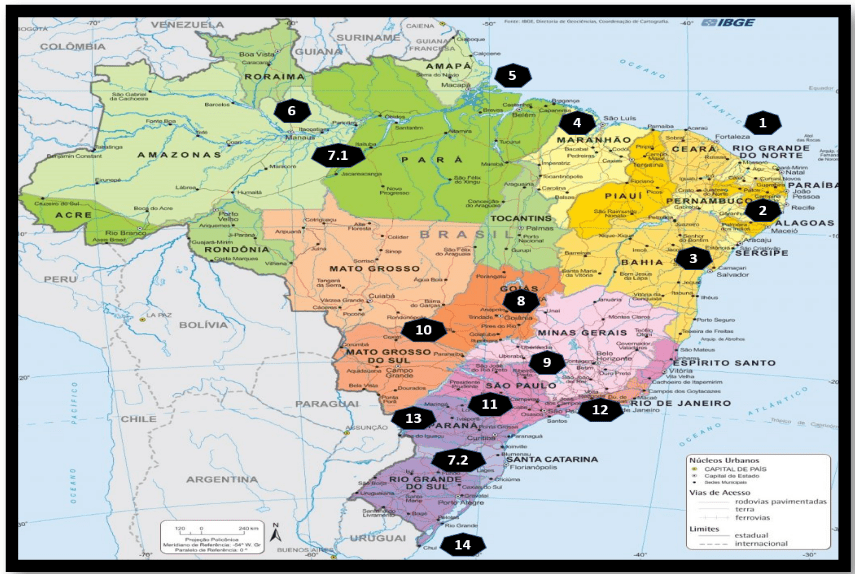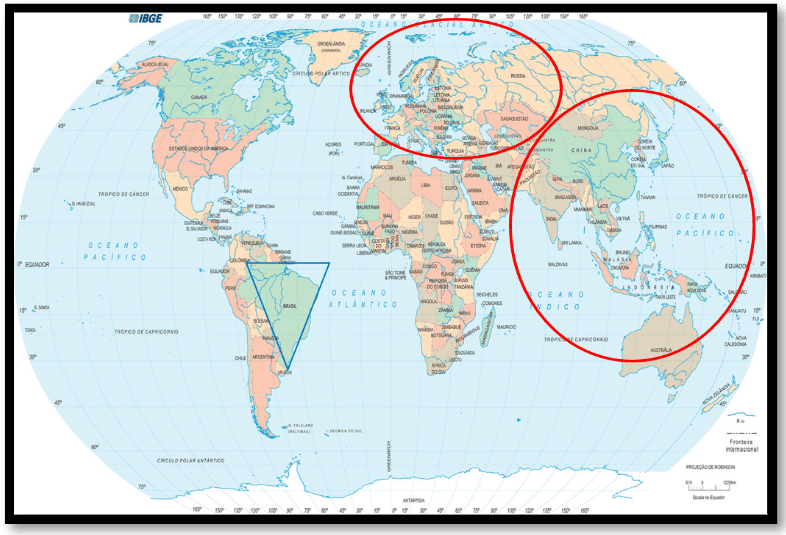Col. Daniel Mendes Aguiar Santos
In January 2022, here on EBlog, I published an article entitled The War of the Future and the containment of the “dragon”, presenting the upsurge in global competition between the United States of America (USA) and China, highlighting that the American National Security Strategy already identified China, Russia, North Korea and Iran as potential adversaries, contrary to the democratic ideology. Then, in February, Kiev was bombed and the eastern and southern regions of Ukraine were taken over by the Russian Army. Since then, the world has witnessed growing friction, most notably the Ukrainian War and tensions in Taiwan.
In this context, from the point of view of the Military Sciences, the phenomenon of war tends to materialize according to two hypotheses: between asymmetric forces, in the case of the current conflict between Russia and Ukraine; or between equipollent forces, in the case of a hypothetical conflict between the USA and China. In both cases, an attacking force (holding the initiative) and a defending force (holding the ground) will seek alliances and shape the elements of force, time and space, at the level of strategy (what to do) and at the level of tactics (how to do it).
Sensing an ever-closer equipoise on the part of its adversaries, the US has identified the need to be ready to conduct Large Scale Combat Operations. In particular, China’s Anti-Access/Area Denial (A2/AD) defense system in the Pacific Ocean led the US to outline an operational concept capable of enabling the conduct of Joint Forcible Entry Operations, considering the possibility of preventive, pre-emptive or counter-offensive action in the face of an attempt/invasion of Taiwan by China. Thus, the Multi-Domain Operations approach proposes analyzing the operational environment in three dimensions (physical, informational and human) and in five domains (land, air, sea, space and cyber). In this context, the US Armed Forces have begun to focus on the interdependence between the domains in order to subdue an equipollent adversary and, to this end, they prioritize the convergence of operations in order to obtain “windows of opportunity/superiority” in order to destroy, displace, disintegrate and isolate the opponent.
As a result of this global situation, the importance of National Defense shines through for all nations, as an instrument for guaranteeing sovereignty and national interests.
In Brazil’s case, it is necessary to look at the strategic environment, with attention to South America and the South Atlantic, which has its own peculiarities, such as: the instability in Venezuela and the consequent refugee crisis; the action of the National Liberation Army (ELN) and the drug trafficking cartels stationed in Colombia; the presence/action of private military groups; the French military presence in its overseas department; the island possessions of the United Kingdom; Chinese prospecting for the installation of naval bases; and the expiry of the Antarctic Treaty (2041). Moving forward, it is worth noting that the Brazilian state is required to guarantee the inviolability of its 8,514,876 km² of territory, with 7,367 km of coastline and 16,886 km of land border, as well as preserving more than 200 million inhabitants. Furthermore, it is crucial to protect strategic national assets (figure 1), such as:
(1) the mineral heritage of the Blue Amazon, which encompasses the territorial sea, the exclusive economic zone and the edge of the continental shelf, with attention to the oil fields, which are essential to energy security;
(2) the national port system, responsible for projecting vessels into the maritime domain, especially in the South Atlantic;
(3) the set of petrochemical centers, crucial for supplying inputs used by the country’s various production chains;
(4) the Rocket Launch Base (Alcântara/MA), which is highly relevant for space exploration;
(5) the mouth of the Amazon River, a point of great geostrategic value for access to the Amazon Region, both by sea and by land;
(6) the mineral and plant heritage of the Legal Amazon, which concentrates a plethora of deposits and reserves of national interest;
(7) the water supply from the Alter do Chão Aquifer (Amazon) and the Guarani Aquifer (Center-South), which are crucial for future water security;
(8) the Federal Capital (Brasília/DF), which concentrates the structures and management systems of the National Power;
(9) the reserves of niobium, an extremely resistant metal used in complex metallurgical processes, especially Araxá/MG;
(10) the agricultural complex, which is essential for food security, especially in the states of Minas Gerais, São Paulo, Paraná, Mato Grosso do Sul and Mato Grosso do Sul;
(11) the industrial complex, including the Defense Industrial Base, which is crucial to sustaining the diversity of national production, concentrated in the SE and S regions;
(12) nuclear assets, including the Angra 1 and 2 plants and the Brazilian Nuclear Industry (Resende/RJ), essential for diversifying the energy matrix and the Defense Industry;
(13) the Itaipu Binacional Hydroelectric Power Plant (Foz do Iguaçu/PR), essential for energy security; and
(14) access to Antarctica via the South Atlantic, the closest navigation route to the continent, considering the end of the Antarctic Treaty (2041) and, from then on, the probable “race” to the frozen continent.

In order to manage such a responsibility, it is necessary to think about National Defense, reflecting on the quality of the “insurance” that the country believes is necessary to preserve sovereignty and national interests. Under the lens of National Power, the construction of our “insurance” will take place through the integration of political, economic, psychosocial, military and scientific-technological expressions. To this end, the integration of civilians and the military is essential, as in the case of the legacy of Professor Therezinha de Castro and General Meira Mattos, who contributed with their indigenous strategic visions. In particular, Therezinha de Castro pointed out the importance of the South Atlantic, including the Antarctic projection thesis, for National Defense. For his part, Meira Mattos stressed the need to occupy, take advantage of and integrate the Amazon Region with the rest of the country, as well as indicating the “widening of the security perimeter” in South America and the South Atlantic as a critical aspect for National Defense.
Moving forward, in 1999, with the creation of the Ministry of Defense, military expression became unified in favor of joint operations. Since then, progress has continued, with emphasis on the adoption of Capability-Based Planning (CBP), a methodology used to model the joint capabilities needed for Defense. In this sense, the Armed Forces’ Strategic Projects (Tamandaré Frigate, PROSUB, Guarani, SISFRON, KC-390, F-39/Gripen, among others) have become the vectors for instrumentalizing these capabilities. In particular, as a result of the current technological leaps, budget support and contractual stability are more important than ever for obtaining and operationalizing joint capabilities in a timely manner.
Therefore, inserted in a complex world, volatilized by conflicts in Eurasia and tensions in East Asia, we are urged to revisit General Meira Mattos’ thoughts on the “widening of the security perimeter”, observing the perimeter of a “defense triangle” (North, East and West), potential for the configuration of an anti-access and area denial structure, where joint capabilities converge (figure 2). In this context, EB’s new operational concept, Convergence Operations 2040, already indicates the use of the Ground Force in favor of the synergy of joint capabilities, maximizing superiority in confrontation. Finally, it is important to reaffirm the importance of National Defense as a condition for the country’s development and, therefore, to persevere in actions and studies to guarantee the inviolability of our territory.

-x-
About the author:
Colonel Daniel Aguiar is an Officer of the Cavalry Weapon, a graduate of AMAN’s Class of 1999, having completed the High Military Studies Course in 2016-2017. He commanded the 13th RC Mec, Pirassununga/SP (2022-2023); the Cavalry Course at the Officer Training School, Rio de Janeiro/RJ (2021); and the 10th Esqd C Mec, Recife/PE (2014-2015). In particular, he was the Commander of the FT Mechanized Subunit, part of the 10th Motorized Infantry Brigade, in the VI Contingent of Operation São Francisco, in Complexo da Maré/RJ (2016). He was an instructor at the Command and General Staff School, the Officer Training School and the Weapons Sergeants School. He also holds a PhD in Military Sciences from the Meira Mattos Institute (ECEME) with a thesis entitled “Conflict and the Protection of Civilians in Africa: the case of the UN Strategy for the use of force and human security in South Sudan”. He also completed the Command and Joint Staff Course for the Armed Forces of the Republic of Korea, with his Final Paper entitled: “The War of the Future and the Military Strategy for the Korean Peninsula”.
*** Translated by DEFCONPress FYI Team ***
